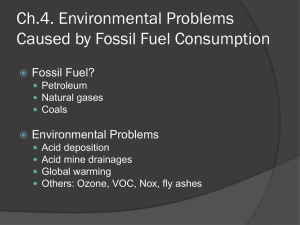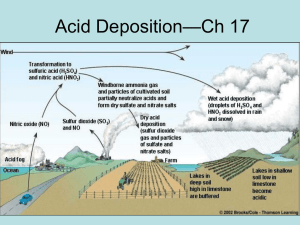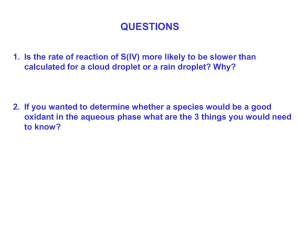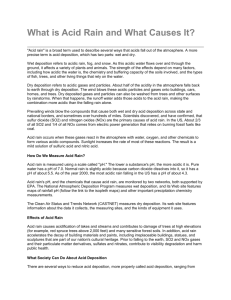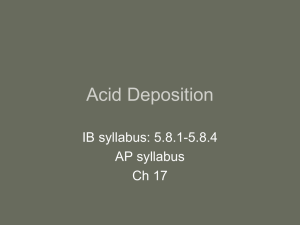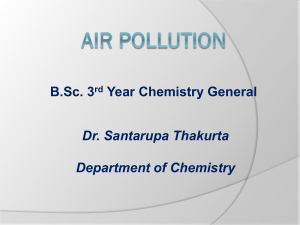CH217-Acid-Rain
advertisement
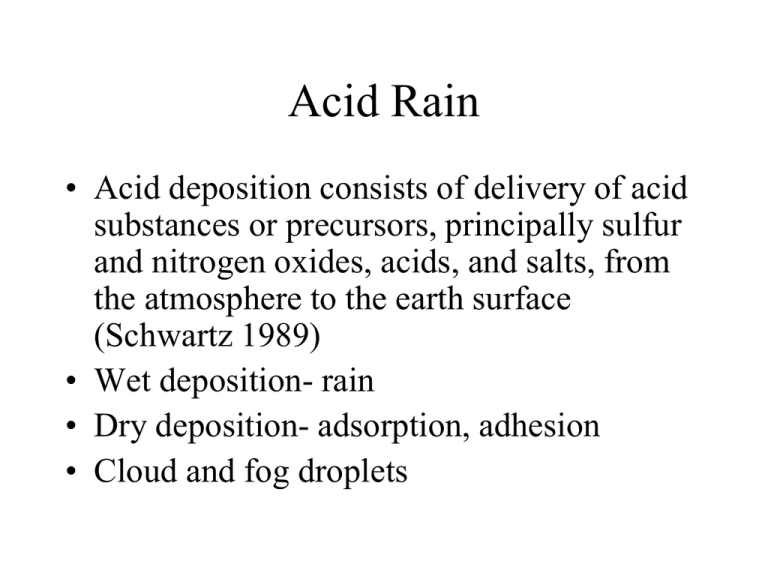
Acid Rain • Acid deposition consists of delivery of acid substances or precursors, principally sulfur and nitrogen oxides, acids, and salts, from the atmosphere to the earth surface (Schwartz 1989) • Wet deposition- rain • Dry deposition- adsorption, adhesion • Cloud and fog droplets pH of rain pKg = 1.41 pK1 = 6.35 pK2 = 10.33 pH of pure water? Background • Acid precipitation recognized over 100 years ago – – – – – Smith 1840 -1870 (SO42- higher in urban areas) Sweden 1950’s and 60’s regional problem decrease in rain pH source of air influenced rain pH • Likens started work in the US in the early 1970’s – huge $$$$ in the 1980’s • Current research Schwartz(1989) Acid Deposition: Unraveling a Regional Phenomenon, Science 243:753. Current Research • Emissions - What are the sources? – rates – distribution – cost • Atmospheric Processes – – – – concentrations reaction mechanisms transport and reaction rates removal rates • Effects -Why do we care? Major sources of Nitrogen and N/1012 g/y NH3 Biogenic 122 NOx stratosphere 1 lightning 5 biogenic 8 biomass comb. 12 fossil fuel 20 F Sulfur S/10 12 g/y Solids sea salt dust Reduced biogenic Partially oxid. fossil fuel Volcanoes 44 20 98 104 5 Spatial Distribution of Emissions Spatial Distribution of Emissions Nitrogen Oxides Affected Sources in the EPA’s Acid Rain Program Affected sources are determined by NOx and SO2 emission rates and fuel consumption. Phase I began in 1995, affecting 445 of the larger emitting units. Phase II began in 2000 and includes smaller plants as well, affecting over 2000 units. http://www.epa.gov/airmarkets/progsregs/arp/basic.html Historical Trends The Current Limits • US Standard (Atmospheric Concentration) – SO2 – NO2 1.2 mol/m3 2.1 mol/m3 • Deposition limits (suggested) – SO2 20-40 mol/m2 yr (wet and dry deposition) – NO2 40-80 mol/m2 yr (wet and dry deposition) http://www.epa.gov/ord/htm/CAAA-2002-report-2col-rev-4.pdf http://www.epa.gov/airmarkets/arp/index.html Emissions • Newton’s law of air pollution - What goes up must come down! • From emission rates we can define a deposition rate, but not a distribution! • OHIO river valley – SO2 – NO2 360 mmol/m2 yr. 210 mmol/m2 yr. • Northeast – SO2 – NO2 130 mmol/m2 yr. 120 mmol/m2 yr. • These levels are 2-10 times lower than emission levels! • Where do the acidic emissions go? Deposition of NOx and SO2 • Wet deposition – – – – Rain, snow, fog SO2 and NOx form HNO3 and H2SO4 Soluble gasses that dissolve in raindrops The H cation goes into solution, causing acid rain • Dry deposition – Particulates and aerosols absorbed by plants or deposited on surfaces – Ammonia and sulfuric acid form ammonium sulfate, a particle that water condenses around to form clouds and thus aerosols. Land directly on surfaces. – If Nitric Acid doesn’t go into solution, it can directly deposit on the ground Overview SO2 Chemistry • SO2 - rapid dry deposition (not water soluble) • SO42-, H2SO4 - almost entirely as aerosols (very soluble) SO2 Chemistry • Combustion processes produce SO2. • SO2 can be dry deposited to the earth or can be oxidized in the atmosphere • Gas phase reactions: (1-5% hr) SO2 + ·OH Þ M Þ HOSO2 HOSO2 + O2 Þ SO3 + HO2 SO3 + H2 O Þ M Þ H 2 SO4 __ __ __ __ __ __ __ __ __ __ __ __ __ __ _ net · OH + SO2 + O2 + H 2O Þ H2 SO4 + HO2 SO2 Chemistry • Aqueous phase (cloud based reactions): 10%/minute SO2 + H2 O Û HSO3- + H + Û SO3- + 2 H + 2+ HSO3 + H 2O2 Þ M Þ SO4 + H + H2 O or HSO3- + O3 Þ SO42- + O2 + H + Simple Chemical Model O3, OH, H2O2 Oxidation SO2 H2SO4 H2O Dissolution 2H+ + SO42- SO2 Dry Deposition after Parks (1985) Wet Deposition Overview NO2 Chemistry • NO - Not surface active (not water soluble) • NO2 - dry deposition • HNO3 - very volatile, soluble, surface active NO2 Chemistry • Combustion processes produce NOx. • NOx can be dry deposited to the earth or can be oxidized in the atmosphere • Gas phase reactions: (hours) NOx + O3 Þ NO2 + O2 NO + HO2 Þ NO2 + OH NO2 + OH Þ M Þ HNO3 NO2 Chemistry • Gas/Liquid (cloud based reactions): Simple Chemical Model O3, OH, H2O2 Oxidation NO2 NO HNO3 H2O Dissolution H+ + NO3- Dry Deposition Wet Deposition after Parks (1985) Acid Rain Distribution Water • • • Of all acidic lakes (larger than 10 acres), 75% are acidic because of acid rain. This is true for 50% of acidic streams as well. Most effected lake areas are in mountainous regions. Effected streams are those which run over thin soil. Land • • Areas of thin soil (Northeast United States) display more effects from acid rain as there is little or no buffering of the acid. Nutrients are destroyed and toxic metals are released in acidic soil. Vegetation • • The leaves of trees and plants are stripped of nutrients by acid rain. Most effected are trees at high elevation which are constantly surrounded by acidic clouds. Others • • • Metals, paints and stone exposed to acid rain are corroded. $61 million is spent each year on coating new cars and trucks sold in the US to prevent possible damage by acid rain. Sulfate particles account for 50 to 70 percent of the visibility reduction in the eastern part of the United States www.epa.gov Lindsey Boyle Geochemical Effects of Acid Rain The ability of soils to neutralize some or all of the acidity of acid rainwater is called “buffering capacity.” High buffering capacities lead to soils that do not become acidified. Differences in soils are an important reason why some areas that receive acid rain show more damage than other areas that receive the same amount. “The ability of forest soils to resist acidity depends on the thickness and composition of the soil, as well as the type of bedrock beneath the forest floor. Midwestern states like Nebraska and Indiana have soils that are well buffered. Places like New York's Adirondack and Catskill Mountains, have thin soils with low buffering capacity.” Alkaline Soils neutralize the acid directly and have the highest buffering capacity. H+ +CaCO3 Ca2+ + HCO3Granite soils and volcanic rocks are not good at neutralizing acid. Thicker soils are better than thin ones because they have a larger ion exchange. Soils with negative and positively charged particles will have hydrogen replace the positively charged particles. This is bad because the Na, NH 4, Ca etc. are important as nutrients and when they are leached away it buffers the acid but leaves the plants with little nutrients. Thin soils have smaller buffering capacities because all nutrients are leached easily. The ecological effects of acid rain can also be seen in the water environments. Acid rain flows to water sources after falling on land, buildings, and roads. Most lakes and streams have a pH between 6 and 8, although some lakes are naturally acidic even without the effects of acid rain. Acid rain primarily affects sensitive bodies of water, which are located in watersheds whose soils have a limited ability to neutralize acidic compounds. Lakes and streams become acidic when the water itself and its surrounding soil cannot buffer the acid rain enough to neutralize it. In areas where buffering capacity is low, acid rain also releases aluminum from soils into lakes and streams; aluminum is highly toxic to many species of aquatic organisms. Natalie Maida Source: EPA, geocities Damage To Trees Acid Deposition - Biology Freshwater Lakes Since only about 10% of the water in lakes and streams comes from rainfall, the acidity of water of freshwater lakes and streams is mostly determined by the soil and rock types of an area. An area that is most vulnerable to acidification is one that has granite or peat-based soil. Acidification of a lake occurs over a period of time, but initially acidification of freshwater, causes it to be clear blue. This is due to the settling of decaying organic matter. Wildlife Even though the total amount of living organisms remains constant, the diversity of an acidified body of freshwater drops significantly. Soft bodied animals like leeches, snails, and crayfish die with a very little change in acidity, which is often an indicator of acidification. Acidification of freshwater greatly affects fish populations. A decrease in pH is often paired with an increase in toxic metals like aluminum and mercury. A decrease in pH and elevated aluminum concentration will increase fish mortality, decrease fish growth, decrease egg production and embryo survival, and result in physiological impairment of adult fish. Aluminum in the water can precipitate onto fish gills, which would inhibit diffusion and result in respiratory stress. Acid rain is extremely detrimental to amphibian populations. Most amphibians lay their eggs in small, shallow ponds which receive most of their water from rainfall. A very small amount of acidic rainfall would kill any embryos in these small ponds. Trees Acid rain does not directly kill trees. Acidic water dissolves the nutrients and minerals in the soil and washes them away before trees and plants can absorb them out of the ground for use. Acid rain also releases toxic substances such as aluminum into the soil which in very small amounts are very harmful to trees. Trees high up in the mountains are more at risk to receive acid, from acidic clouds and fog. The trees are often bathed in these clouds, which eats away at the waxy protective coating on the leaves. After this occurs, the leaves cannot perform photosynthesis and the trees are left unhealthy, weak, and usually die from disease or from insect attacks. Matt Aschaffenburg, http://www.doc.mmu.ac.uk/aric/eae/Acid_Rain/acid_rain.html pH of lake water as a function of time Metals and acid rain • The solubility of many metals are a function of pH • Example Al • Al2O3.nH2O + 3H+ ---> Al3+ + H2O • Speciation of Al: Al3+, AlOH2+, Al(OH)2+, Al(OH)4• Speciation Diagram Al Speciation Al Concentration as a function of pH • Al in fish gills inhibits Na and Ca transport effects gas transport • Al also precipitates in the gills as Al(OH)3 (s) Costs • Total structural, ecological, and environmental costs are estimated at 5 billion dollars per year • Forests $1.75 B • Agriculture $1.00 B • Corrosion of Buildings $2.00 B • Tourism and fishing $0.25 B • • • • Reduce SO2 Emissions by 40% $1-2 B Reduce SO2 Emissions by 50% $2-4 B Reduce SO2 Emissions by 70% $5-6 B 1990 Clean Air Act -0ver 50% reduction in emissions by the year 2000 Clean Air Act Phases and Reductions Title IV of the Clean Air Act set a goal of reducing annual SO2 emissions by 10 million tons below 1980 levels. To achieve these reductions, the law required a two-phase tightening of the restrictions placed on fossil fuel-fired power plants. Phase I began in 1995 and affected 263 units at 110 mostly coal-burning electric utility plants located in 21 eastern and midwestern states. An additional 182 units joined Phase I of the program as substitution or compensating units, bringing the total of Phase I affected units to 445. Emissions data indicate that 1995 SO2 emissions at these units nationwide were reduced by almost 40% below their required level. Phase II, which began in the year 2000, tightened the annual emissions limits imposed on these large, higher emitting plants and also set restrictions on smaller, cleaner plants fired by coal, oil, and gas, encompassing over 2,000 units in all. The program affects existing utility units serving generators with an output capacity of greater than 25 megawatts and all new utility units. The Act also called for a 2 million ton reduction in NOx emissions by the year 2000. A significant portion of this reduction has been achieved by coal-fired utility boilers that will be required to install low NOx burner technologies and to meet new emissions standards. http://www.epa.gov/airmarkets/arp/ove rview.html Historical Trends Solutions? • Source Receptor Relations (SRR) • Relationships linking sources and deposition • Wide number of approaches are used to establish SRR – No current model is acceptable • General: local sources are more important than we thought • Dry deposition is important • We know what acid rain is doing to the environment • Schwartz asks: – Do we know enough to regulate? – Do we know enough to emit?
